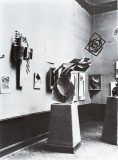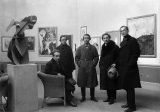Difference between revisions of "First Russian Art Exhibition"
| Line 1: | Line 1: | ||
| − | + | The '''First Russian Art Exhibition''' [Erste russische Kunstausstellung] opened at the Van Diemen Gallery at 21 Unter den Linde in Berlin (not far from the Russian embassy) on 15 October 1922, with more than 700 works by [http://www.maslovka.org/modules.php?name=Content&pa=showpage&pid=653&page=2 167 artists]: paintings, graphic works, sculptures, as well as designs for theater, architectural models, and porcelain. The exhibition's official host was the Russian Ministry for Information, and it was put together by the artists [[Naum Gabo]], [[David Sterenberg]], and [[Nathan Altman]]. [[El Lissitzky]] designed the catalogue's cover. Gabo was in charge of the three rooms where Russian avant-garde art was presented, including several of his own sculptures. Due to the positive echo in the press and the large number of visitors (ca. 15,000), the exhibition was prolonged to the end of the year, although it had been planned for a shorter period of time. On the initiative of the International Workers' Assistance, it was conceived as a commercial exhibition; the proceeds were to go to "Russia's starving". Version of the exhibition later traveled to Stedelijk Museum, Amsterdam, in spring 1923. | |
| − | |||
| − | The '''First Russian Art Exhibition''' [Erste russische Kunstausstellung] opened at the Van Diemen Gallery at 21 Unter den Linde in Berlin (not far from the Russian embassy) on 15 October 1922, with | ||
After the exhibition, [[Friedrich A. Lutz]], director of the Modern Department, continued to show new art until 1926. The parent company and its subsidiaries were seized by the Nazis in 1935. [http://www.jmberlin.de/berlin-transit/en/orte/vandiemen.php] | After the exhibition, [[Friedrich A. Lutz]], director of the Modern Department, continued to show new art until 1926. The parent company and its subsidiaries were seized by the Nazis in 1935. [http://www.jmberlin.de/berlin-transit/en/orte/vandiemen.php] | ||
| + | |||
| + | <onlyinclude>{{#ifeq:{{{transcludesection|Images}}}|Images| | ||
| + | <gallery> | ||
| + | Erste_russische_Kunstausstellung_1922.jpg|Catalogue, 31+[46] pp. Cover by [[El Lissitzky]]. | ||
| + | Erste_Russische_Kunstaustellung_Berlin_Galerie_van_Diemen_1922.jpg | ||
| + | Organizers_of_the_First_Russian_Art_Exhibition_1922_David_Sterenberg_Nathan_Altmann_Naum_Gabo_Friedrich_Lutz_L-R_photo_Willy_Roemer.jpg|Organisers of the exhibition. L-R: David Sterenberg, D. Marianov, Nathan Altmann, Naum Gabo, Friedrich Lutz (gallery director). Photo: Willy Römer. | ||
| + | </gallery> | ||
| + | }}</onlyinclude> | ||
==Catalogue== | ==Catalogue== | ||
| Line 18: | Line 24: | ||
==Links== | ==Links== | ||
| − | * http://de.wikipedia.org/wiki/Erste_Russische_Kunstausstellung_Berlin_1922 | + | * [http://de.wikipedia.org/wiki/Erste_Russische_Kunstausstellung_Berlin_1922 Exhibition at German Wikipedia] |
{{Avant-garde art exhibitions and events}} | {{Avant-garde art exhibitions and events}} | ||
[[Category:Constructivism]] __NOTOC__ | [[Category:Constructivism]] __NOTOC__ | ||
Revision as of 14:52, 8 August 2015
The First Russian Art Exhibition [Erste russische Kunstausstellung] opened at the Van Diemen Gallery at 21 Unter den Linde in Berlin (not far from the Russian embassy) on 15 October 1922, with more than 700 works by 167 artists: paintings, graphic works, sculptures, as well as designs for theater, architectural models, and porcelain. The exhibition's official host was the Russian Ministry for Information, and it was put together by the artists Naum Gabo, David Sterenberg, and Nathan Altman. El Lissitzky designed the catalogue's cover. Gabo was in charge of the three rooms where Russian avant-garde art was presented, including several of his own sculptures. Due to the positive echo in the press and the large number of visitors (ca. 15,000), the exhibition was prolonged to the end of the year, although it had been planned for a shorter period of time. On the initiative of the International Workers' Assistance, it was conceived as a commercial exhibition; the proceeds were to go to "Russia's starving". Version of the exhibition later traveled to Stedelijk Museum, Amsterdam, in spring 1923.
After the exhibition, Friedrich A. Lutz, director of the Modern Department, continued to show new art until 1926. The parent company and its subsidiaries were seized by the Nazis in 1935. [1]
- Erste russische Kunstausstellung 1922.jpg
Catalogue, 31+[46] pp. Cover by El Lissitzky.
Catalogue
- Erste Russische Kunstausstellung, Berlin, 1922, Galerie Van Diemen & Co., Berlin: Internationale Arbeiterhilfe, [1922], 31 pp, [46] pp of plates. [2]
Literature
- Eckhard Neumann, "Russia's 'Leftist Art' in Berlin, 1922", Art Journal 27:1 (Autumn 1967), pp 20-23. [3]
- Eberhard Roters (ed.), Erste Russische Kunstausstellung: Berlin 1922. Galerie van Diemen & Co., Berlin 1922, Cologne: Nachdruck König, 1988. (in German)
- Roland Enke, "Malevich and Berlin", c2003.
See also
Links
| Art exhibitions and events | ||
|---|---|---|
|
Second Spring Exhibition of OBMOKhU (Moscow, 1920-21), Congress of International Progressive Artists (Düsseldorf, 1922), Congress of the Constructivists and Dadaists (Weimar, 1922), First Russian Art Exhibition (Berlin, 1922), New Art Exhibition (Vilnius, 1923), Zenit Exhibition (Belgrade, 1924), Contimporanul Exhibition (Bucharest, 1924), Machine-Age Exposition (New York, 1927), a.r. International Collection of Modern Art (Łódź, 1931), New Tendencies (Zagreb, 1961-73), The Responsive Eye (New York, 1965), 9 Evenings: Theatre and Engineering (New York, 1966), Cybernetic Serendipity (London, 1968), Live In Your Head: When Attitudes Become Form (Bern, 1969), Information (New York, 1970), Software - Information Technology: Its New Meaning for Art (New York, 1970), Documenta 5 (Kassel, 1972), Pictures (New York, 1977), Biennial of Dissent (Venice, 1977), Les Immatériaux (Paris, 1985), Magiciens de la Terre (Paris, 1989), Hybrid Workspace (Kassel, 1997) | ||

